(Press-News.org) It is supposed to be cool, colorless, tasteless and odorless. It may not have any pathogens or impair your health. This is the reason why drinking water is put to a whole series of screenings at regular intervals. Now, the AquaBioTox project will be added to create a system for constant real-time drinking water monitoring. At present, the tests required by the German Drinking Water Ordinance are limited to random samples that often only provide findings after hours and are always attuned to specific substances. In contrast, the heart of the AquaBioTox system is a bio-sensor that reacts to a wide range of potentially hazardous substances after just a couple of minutes. It works on the taster principle. That is, some drinking water is diverted from the main line through the sensor in a branching descending line and it contains two different strains of bacteria and mammalian cells. On the one hand, these microscopically small bacteria have a large surface that guarantees quick material turnover and reacts to toxic substances within minutes. On the other hand, the mammalian cells clinch the results because of their close relationship to the human organism and they also extend the range of reactions. This is how Dr. Iris Trick from the Fraunhofer Institute for Interfacial Engineering and Biotechnology IGB in Stuttgart, Germany sees it: "We tested various classes of substances that might occur in water – even though they shouldn't – and to date our sensor has reacted to each of these substances." She developed the bio-sensor in joint efforts with her colleague Dr. Anke Burger-Kentischer.
The micro-organisms in the sensor were modified so that they produce a protein that has a red fluorescence. The fluorescence changes if it comes into contact with toxic substances. A highly sensitive camera system that the Karlsruhe, Germany-based Fraunhofer Institute of Optronics, System Technologies and Image Exploitation IOSB came up with has an analysis unit that registers even the most minute changes in fluorescence and then analyzes them automatically. Dr. Thomas Bernard, the group manager at the IOSB, tells us why: "The monitoring unit has a machine-learning process for learning from historical data which fluctuations in the physical, chemical and biological parameters are normal. It sets off an alarm if an unusual pattern shows up in the signals." The bio-sensor reacts to the smallest quantities of hazardous substances and Dr. Trick provides the explanation: "Our sensor can document even very slight concentrations." Let's not forget that classical poisons such as cyanide or ricin as well as plant protectives or toxic metabolic products from bacteria can be fatal even in concentrations of nanograms per liter.
They have to guarantee optimum life conditions for the microorganisms to operate the bio-sensor on a permanent basis. This is the reason why the researchers at the IOSB have come up with a system that automatically monitors and regulates important parameters such as temperature and inflow of nutrients. Another component of the Aqua-BioTox system is a daphnia toximeter of their Kiel, Germany-based project partner bbe Moldaenke, who noticed that water fleas react particularly sensitively to nerve poisons. They are testing this monitoring system in a closed performance route on the grounds of Berlin's water company, that is incidentally another partner in this project. The idea behind it is making the system as small and cost-effective as possible so that a network of sensor units communicating with one another could be installed that is distributed over sensitive points in the drinking water network.
INFORMATION:
The taster in your water line
2010-12-07
ELSE PRESS RELEASES FROM THIS DATE:
Scientists find gene linked to congenital heart defect
2010-12-07
A gene that can cause congenital heart defects has been identified by a team of scientists, including a group from Princeton University. The discovery could lead to new treatments for those affected by the conditions brought on by the birth defect.
Princeton researchers focused on identifying and studying the gene in zebrafish embryos, and the team's work expanded to include collaborations with other groups studying the genetics of mice and people.
"This work really showcases the use of collaborative science and multiple model systems to better understand human disease," ...
Parkinson's drug could treat restless leg syndrome
2010-12-07
AUGUSTA, Ga. – A drug prescribed for Parkinson's disease may also treat restless leg syndrome without the adverse side effects of current therapies, Medical College of Georgia researchers say.
Rasagaline works by prolonging the effect of dopamine, a chemical that transmits signals between nerve cells in the brain. The cause of RLS is unknown, but research suggests a dopamine imbalance. Parkinson's is caused by a dopamine insufficiency.
"The hope is that Rasagaline, because it prolongs the effect of existing dopamine, instead of producing more, will not come with adverse ...
Mayo Clinic finds long-term prognosis is excellent for most children with seizures
2010-12-07
ROCHESTER, Minn. -- Mayo Clinic researchers studied more than 200 children with epilepsy and found that even if the cause of focal-onset seizures cannot be identified and they do not fit into a known epilepsy syndrome, long-term prognosis is still excellent. This study was presented at the American Epilepsy Society's (http://www.aesnet.org/) annual meeting in San Antonio on Dec. 4.
Epilepsy (http://www.mayoclinic.org/epilepsy/) is a disorder characterized by the occurrence of two or more seizures. It affects almost 3 million Americans, and approximately 45,000 children ...
Scientists announce discovery of first horned dinosaur from South Korea
2010-12-07
Cleveland - Scientists from South Korea, the United States and Japan analyzed fossil evidence found in South Korea and published research describing a new horned dinosaur. The newly identified genus, Koreaceratops hwaseongensis, lived about 103 million years ago during the late Early Cretaceous period. The specimen is the first ceratopsian dinosaur from the Korean peninsula. The partial skeleton includes a significant portion of the animal's backbone, hip bone, partial hind limbs and a nearly complete tail. Results from the analysis of the specimen were published in ...
Penn study on skin formation suggests strategies to fight skin cancer
2010-12-07
PHILADELPHIA - In a study published in the journal Developmental Cell, Sarah Millar PhD, professor of Dermatology and Cell & Developmental Biology at the University of Pennsylvania School of Medicine, and colleagues demonstrate that a pair of enzymes called HDACs are critical to the proper formation of mammalian skin.
The findings, Millar says, not only provide information about the molecular processes underlying skin development, they also suggest a potential anticancer strategy. "Inhibition of these HDAC enzymes might be able to shut down the growth of tumors that ...
Bacteria seek to topple the egg as top flu vaccine tool
2010-12-07
Only the fragile chicken egg stands between Americans and a flu pandemic that would claim tens of thousands more lives than are usually lost to the flu each year.
Vaccine production hinges on the availability of hundreds of millions of eggs – and even with the vaccine, flu still claims somewhere around 36,000 lives in the United States during a typical year. Now scientists have taken an important step toward ending the dominance of the oval. In a paper published in the Dec. 6 issue of the journal Vaccine, scientists showed that an experimental flu vaccine grown entirely ...
NIH scientists identify mechanism responsible for spreading biofilm infections
2010-12-07
What: Scientists from the National Institutes of Health have discovered how catheter-related bacterial infection develops and disseminates to become a potentially life-threatening condition. The study, which included research on Staphylococcus epidermidis in mice implanted with catheters, could have important implications for understanding many types of bacterial biofilm infections, including those caused by methicillin-resistant S. aureus (MRSA).
Biofilms are clusters of microbes that almost always are found with healthcare-associated infections (HAIs) involving medical ...
Iron deficiency in soil threatens soybean production
2010-12-07
Madison, WI December 6 2010 -- An expansion of soybean production into areas where soybean has seldom, if ever, been grown can be problematic for some farmers. Soils having high pH values and large amounts of calcium and/or magnesium carbonate are notoriously iron deficient. Iron deficient soils in the North Central United States are estimated to reduce soy bean production by 12.5 million bushels every year.
John Wiersma, a researcher at the University of Minnesota Northwest Research and Outreach Center at Crookston, concluded a study examining the effect of nitrogen based ...
UNC expert: Combining exenatide with insulin may be 'best result ever' for diabetes patients
2010-12-07
CHAPEL HILL, N.C. – A new study finds that combining the newer diabetes drug exenatide with insulin provides better blood sugar control in patients with type 2 diabetes than insulin alone and helps promote weight loss.
"This study may be the best result ever for patients whose diabetes is inadequately controlled on a combination of pills and insulin," said John Buse, MD, PhD, lead author of the study and chief of the Division of Endocrinology and Metabolism in the University of North Carolina at Chapel Hill School of Medicine.
"Until now, it was inconceivable that you ...
Personalized vaccine for lymphoma patients extends disease-free survival by nearly 2 years
2010-12-07
(ORLANDO, Fla.) – A personalized vaccine is a powerful therapy to prevent recurrence among certain follicular lymphoma patients, according to the latest results of ongoing research led by the University of Pennsylvania School of Medicine. The new findings show that when these patients – whose tumors are marked by a specific protein that may be present in up to half of people with this type of cancer -- receive a vaccine made from their own tumor cells, disease-free survival is improved by nearly two years, compared with patients who receive a placebo. Based on the new analysis, ...



